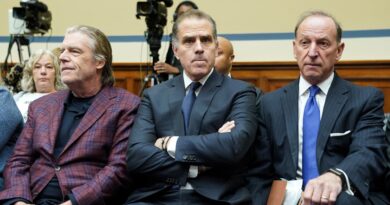All information exhibits inflation is not going away, making issues robust on Fed
A buyer outlets for meals at a grocery retailer on March 12, 2024 in San Rafael, California.
Justin Sullivan | Getty Photographs Information | Getty Photographs
The final batch of inflation information that Federal Reserve officers will see earlier than their coverage assembly subsequent week is in, and none of it is vitally good.
Within the combination, Commerce Division indexes that the Fed depends on for inflation alerts confirmed costs persevering with to climb at a charge nonetheless significantly greater than the central financial institution’s 2% annual objective, in line with separate experiences this week.
Inside that image got here a number of salient factors: An abundance of cash nonetheless sloshing by means of the monetary system is giving shoppers lasting shopping for energy. The truth is, consumers are spending greater than they’re taking in, a scenario neither sustainable nor disinflationary. Lastly, shoppers are dipping into financial savings to fund these purchases, making a precarious situation, if not now then down the street.
Put all of it collectively, and it provides as much as a Fed more likely to be cautious and never within the temper anytime quickly to begin slicing rates of interest.
“Simply spending some huge cash is creating demand, it is creating stimulus. With unemployment beneath 4%, it should not be that shocking that costs aren’t” happening, stated Joseph LaVorgna, chief economist at SMBC Nikko Securities. “Spending numbers aren’t happening anytime quickly. So that you may need a sticky inflation situation.”
Certainly, information the Bureau of Economic Analysis released Friday indicated that spending outpaced revenue in March, because it has in three of the previous 4 months, whereas the non-public financial savings charge plunged to three.2%, its lowest stage since October 2022.
On the similar time, the personal consumption expenditures price index, the Fed’s key measure in figuring out inflation pressures, moved as much as 2.7% in March when together with all objects, and held at 2.8% for the very important core measure that takes out extra risky meals and vitality costs.
A day earlier, the division reported that annualized inflation within the first quarter ran at a 3.7% core charge within the first quarter in whole, and three.4% on the headline foundation. That got here as real gross domestic product growth slowed to a 1.6% tempo, properly under the consensus estimate.
Hazard situations
The cussed inflation information raised a number of ominous specters, particularly that the Fed may have to keep rates elevated for longer than it or monetary markets would really like, threatening the hoped-for tender financial touchdown.
There’s an much more chilling risk that ought to inflation persist central bankers could need to not solely contemplate holding charges the place they’re but additionally contemplate future hikes.
“For now, it means the Fed’s not going to be slicing, and if [inflation] would not come down, the Fed’s both going to need to hike in some unspecified time in the future or maintain charges greater for longer,” stated LaVorgna, who was chief economist for the Nationwide Financial Council beneath former President Donald Trump. “Does that finally give us the arduous touchdown?”
The inflation downside within the U.S. at present first emerged in 2022, and had a number of sources.
At first of the flare-up, the problems got here largely from provide chain disruptions that Fed officers thought would go away as soon as shippers and producers had the possibility to catch up as pandemic restrictions eased.
However even with the Covid financial disaster properly within the rearview mirror, Congress and the Biden administration proceed to spend lavishly, with the finances deficit at 6.2% of GDP on the finish of 2023. That is the very best exterior of the Covid years since 2012 and a stage typically related to financial downturns, not expansions.
On prime of that, a still-bustling labor market, through which job openings outnumbered obtainable employees at one level by a 2 to 1 margin and are nonetheless at about 1.4 to 1, additionally helped maintain wage pressures excessive.
Now, even with demand shifting again from items to providers, inflation stays elevated and is confounding the Fed’s efforts to sluggish demand.

Fed officers had thought inflation would ease this yr as housing prices subsided. Whereas most economists nonetheless anticipate an inflow of provide to tug down shelter-related costs, different areas have cropped up.
For example, core PCE providers inflation excluding housing — a comparatively new wrinkle within the inflation equation nicknamed “supercore” — is operating at a 5.6% annualized charge over the previous three months, in line with Mike Sanders, head of mounted revenue at Madison Investments.
Demand, which the Fed’s charge hikes have been alleged to quell, has remained strong, serving to drive inflation and signaling that the central financial institution could not have as a lot energy because it thinks to convey down the tempo of worth will increase.
“If inflation stays greater, the Fed can be confronted with the tough selection of pushing the financial system right into a recession, abandoning its soft-landing situation, or tolerating inflation greater than 2%,” Sanders stated. “To us, accepting greater inflation is the extra prudent possibility.”
Worries a couple of arduous touchdown
To this point, the financial system has managed to keep away from broader injury from the inflation downside, although there are some notable cracks.
Credit score delinquencies have hit their highest stage in a decade, and there is a rising unease on Wall Road that there is extra volatility to return.
Inflation expectations are also on the rise, with the intently watched University of Michigan consumer sentiment survey displaying one- and five-year inflation expectations respectively at annual charges of three.2% and three%, their highest since November 2023.
No much less a supply than JPMorgan Chase CEO Jamie Dimon this week vacillated from calling the U.S. financial growth “unbelievable” on Wednesday to a day letter telling The Wall Road Journal that he is anxious all the federal government spending is creating inflation that’s extra intractable than what’s at the moment appreciated.
“That is driving a number of this development, and that can produce other penalties presumably down the street known as inflation, which can not go away like individuals anticipate,” Dimon stated. “So I take a look at the vary of attainable outcomes. You may have that tender touchdown. I am a bit extra anxious that it is probably not so tender and inflation could not go fairly the way in which individuals anticipate.”
Dimon estimated that markets are pricing within the odds of a tender touchdown at 70%.
“I feel it is half that,” he stated.





